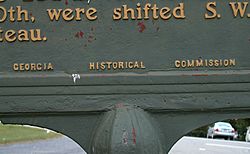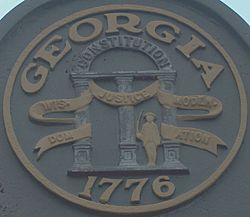Georgia Historical Commission facts for kids


The Georgia Historical Commission was a group created by the U.S. state of Georgia to protect and preserve its history. The state government formed the commission in February 1951. Its main goal was to teach people about the history of Georgia.
Even though the commission was only around for a short time, it did a lot of important work. One of its biggest projects was putting up hundreds of historical markers all over the state. These signs tell the stories of important people, places, and events. You can still see many of these markers today.
Contents
Why the Commission Was Created
The idea for the commission came from several places. Across Georgia, local history groups were trying to save important old buildings and sites. These projects were a big deal for the whole state.
However, these local groups often needed money and expert help. They also needed a way to work together with other state projects.
Three Leaders with a Big Idea
Three community leaders from Atlanta saw this problem and pushed for a state historical commission.
- Henry A. Alexander, a attorney, became the first chairman of the commission.
- Joseph Jacobs, a pharmacist.
- Frank Boland, a physician (a type of doctor). Dr. Boland especially wanted to create a memorial for Crawford W. Long. Dr. Long was a Georgian who was the first to use ether to prevent pain during surgery, a major step in modern medicine.
Getting the Government on Board
Secretary of State Ben Fortson supported the idea. He thought the commission should be part of his department, which already took care of Georgia's official records and archives.
Governor Herman Talmadge also agreed to support the new commission. He thought it was a positive project that many people in Georgia would like.
The Commission's Work and Growth
The commission had a slow start. The law that created it said it could not receive money from the state. This meant it had no budget to do any work.
Luckily, this rule was changed in 1952. With state funding, the commission quickly grew into an important agency. C. E. Gregory, who had helped campaign for the commission, became its first leader. In 1960, his daughter, Mary Gregory Jewett, took over the job. She had already been working as the commission's main historian.
Over time, the commission grew to have a staff of 15 people. It was guided by a board of nine members. Experts like the building historian William R. Mitchell Jr. and the archaeologist Lewis H. Larson Jr. also helped advise the commission on its projects.
Major Accomplishments
The Georgia Historical Commission became known across the country for its great work in preserving history. It had two major achievements that left a lasting mark on the state.
Restoring Historic Sites
One of the commission's biggest successes was saving and restoring 20 important historic sites. This work included buying the land, fixing up old buildings, and even digging to find ancient artifacts (archaeology).
Fifteen of these sites had staff to guide visitors, and seven of them included museums. Two of the most famous sites the commission developed were New Echota, the former capital of the Cherokee Nation, and the Chief Vann House Historic Site.
Creating Historical Markers
The commission's other major project was creating and putting up about 1,800 historical markers. These signs are placed along roadsides and in towns to share interesting facts about Georgia's past.
Between 1962 and 1965, there was a special focus on the American Civil War. The commission worked hard to place 750 markers about the Civil War before the 100th anniversary of its end.
Starting in 1966, the commission also helped decide which places in Georgia should be added to the National Register of Historic Places, a list of the nation's most important historical sites.
The End of the Commission
In 1973, Governor Jimmy Carter made changes to the state government. As part of this reorganization, the Georgia Historical Commission was closed down after 22 years of work.
Although the commission was gone, its important work continued. The Department of Natural Resources took over the job of caring for most of the historic sites and museums. The Georgia Historical Society became responsible for the historical marker program. Today, some of the sites are managed by local community groups, making sure that Georgia's history is preserved for everyone to enjoy.

